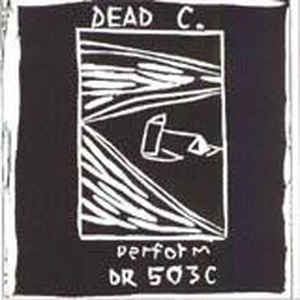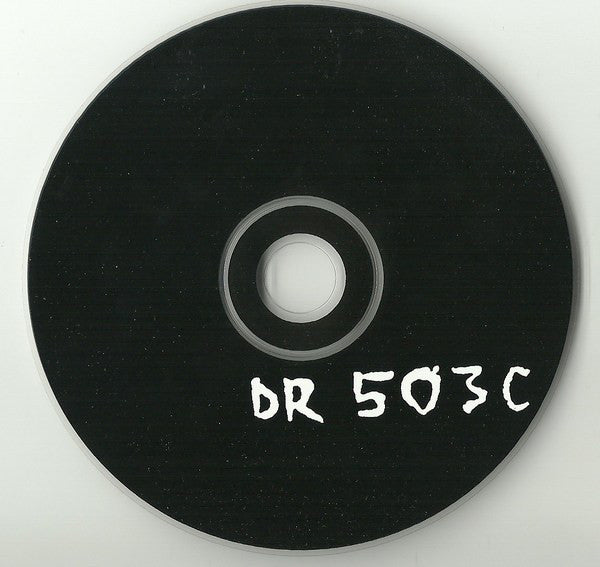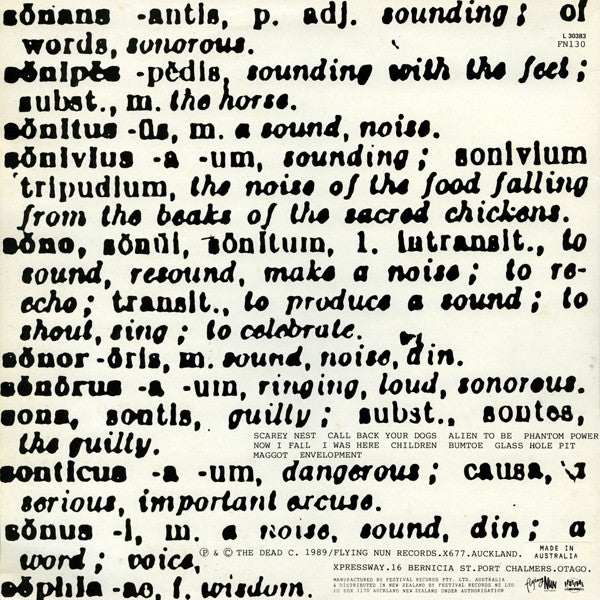THE DEAD C | BAND

THE DEAD C - JON DALE
January 1987 was an auspicious month in the history of New Zealand music, for it gave birth to The Dead C, parented by a likely triumvirate of punk rock endeavour, DIY culture, and warehouse living.
The then-Dunedin based trio of Bruce Russell (guitar, electronics), Michael Morley (guitar, electronics) and Robbie Yeats (drums, electronics) had prior form within the Flying Nun milieu – Yeats as drummer with The Verlaines, Morley as leader of The Weeds and Wreck Small Speakers On Expensive Stereos, and Russell as helper/correspondent at FN headquarters. Yet, while their music, a detourned version of rock sometimes called noise-rock or free-rock, drew from the well of inspiration offered by their Flying Nun predecessors, The Dead C pushed further, farther, for far longer. (Imagine Patti Smith’s “Radio Ethiopia/Abyssinia” extended out into eternity, while huffing on fumes from Donald Miller’s guitar amp.)
Releasing their first two albums, 'DR503' and 'Eusa Kills' on Flying Nun, with various cassettes and LPs appearing alongside – some of the cassettes released via Russell’s Xpressway and Morley’s Precious Metal imprints – these early recordings best document their uneasy alliance with the rock beast. Morley’s songs are repeatedly flayed by Russell’s untutored guitar noise, and Yeats’s drums regularly seem to be leading the songs, usually off the edge of a cliff. This period reaches its peak with 1992’s 'Harsh ‘70s Reality', a double album whose concept is as ungraspable as the four sides of vinyl are elemental, hallucinogenic. Still considered their finest hour by many, it’s the point at which they broke through and beyond the confines of the song, and many of their next batch of albums, 'The Operation Of The Sonne', 'Repent', 'The White House' anon, essayed an uneasy, unravelled form of improvised rockist grunt that undid itself as it poured forth from the members’ fingertips.
With the group a divisive presence in their homeland, they found greater favour overseas, and indeed they have shacked up with a number of American labels (Siltbreeze, Ba Da Bing!, Forced Exposure, Sub Pop), earned the patronage of Sonic Youth and Lou Reed, and inspired a cabal of international noise and rock artists who channel, extend, or sometimes just outright rip off The Dead C’s disobedient take on rock music. Their closest peers are (or have been), perhaps, Keiji Haino’s now-defunct Fushitsusha, the USA’s Charalambides, or England’s Skullflower – all groups whose tangential relationship to the formal concerns of rock, combined with a reverence toward the genre at its most ‘out’, has them posted on an aesthetic precipice whereby their music sounds like the simultaneous destruction and re-construction of its basic building blocks.
In the later part of the ‘90s, and a good portion of the ‘00s (please, don’t call them the noughties), The Dead C lifted their anchor and sailed free of structure, essaying some of the most elevated dawn raids on modern electronic improvisation – that they did this with low-cost kit that often sounded like it was standing on the verge of falling apart suggests alchemical processes, magic in the air. When they did return to songs – “Trust” on The Damned, most of 'Secret Earth', or a hilarious appearance on New Zealand music television show Ground Zero, where their rendition of “Sky” terrified the early twenties dunderhead co-hosts – they hit with renewed force, as though the song was well overdue to be desacralized.
All this, and more – Russell has also run two labels, Xpressway and Corpus Hermeticum, records solo, is the key conceptualist of A Handful Of Dust, a free-improvising duo with Alastair Galbraith which is also a sometime trio with Peter Stapleton, and is a noted writer and polemicist, contributing to music magazine The Wire, and recently publishing a book of essays, Left-Handed Blows. Morley, one of New Zealand’s most significant contemporary artists, also records solo as Gate, and has recently been found on record with Sonic Youth’s Lee Ranaldo. Yeats has done time behind the kit for The Renderers and Trash, among others, including an astonishing turn on Mary Rose Crook & The Renderers’ Ghosts Of Our Vegas Lives. In recent years, The Dead C have toured America, been invited to perform at the All Tomorrows Parties, Le Weekend and What Is Music festivals, and overseen a series of vinyl reissues of earlier titles – including, finally, the re-appearance of their very first cassette, The Dead See Perform Max Harris. About time!
One of the song titles on their 2007 album, 'Future Artists', has The Dead C as “The AMM Of Punk Rock”, which is a fair enough call. English ‘laminar’ improvising outfit AMM have spent the last forty-five years liberating free music from its orthodoxies, suggesting ways forward for players locked in entente cordiale in real time. The Dead C do something very similar with punk rock. And yet, the title they should claim, as is their right, is even simpler, yet just as true – the greatest rock group of the Southern Hemisphere.
- JON DALE
Jon Dale writes about music and culture for Uncut, Dusted, Signal To Noise, Resident Advisor and more. He is researching DIY aesthetics, English post-punk and Industrial music for a PhD at the University Of Adelaide. Previous work includes teaching at the University of Adelaide and University of South Australia; guest curation for Adelaide's Mercury Cinema; research into body/performance art, experimental film, conceptual art, and critical theory; running record labels, making music, self-publishing, writing for The Wire, Australian Book Review, etc.
THE DEAD C ARE FROM OUTER SPACE? - ALAN HOLT
My first reaction when Roger asked me to write something on the Dead C was to ask if it would be ok if it was fiction - I was envisioning some kind of Sci-Fi horror involving time travel, silver robots, semi-translucent winged monsters and maybe a fairy princess.
Roger said ‘of course’ (I hadn’t mentioned the robots etc…) On reflection it occurred to me that this idea was borderline dumbass and the results would not really contribute much to the casual fan’s (or anyone’s for that matter) understanding of the band, even though it would have been fun for me re-imagining the band as a cadre of cosmic post-apocalyptic multidimensional freedom fighters – which, I guess, in away, they kind of are anyway.
My first Dead C purchase was their second album 'Eusa Kills'. I am not sure why I bought it. It may have been from hearing Bad Politics on student radio, or it may have been from reading an advert in RipItUp comparing them to Peru Ubu and early Black Flag. Perhaps it was the cover with the back cover text about the sacred chickens…
Regardless, at that time, they were not real popular with my peers; only one of my friends had a copy of 'DR503' and she did not like it, saying it was unnecessarily difficult listening and intentionally annoying – this coming from a Pussy Galore fan, go figure… Any way I remember getting the record home putting it on the stereo and for some reason my first thought was ‘not this is annoying semi-formless crap’ at all but a resounding “YES!”.
My purchase of the record came soon after purchasing, and having my mind blown by, Daniel Johnson’s album 'Hi, How Are You?' One of the qualities that linked the two albums together was a similar creative philosophy of making music with whatever instruments and recording devices were on hand regardless of said instruments or devices being considered ‘professional’. Daniel recorded on a cheap cassette deck and for one song sang over a scratchy instrumental record. The Dead C used Michael’s cassette 4-Track, cheap microphones, battered guitars/drums/CD players… whatever they had sitting around… to get the job done. In a time when everyone in Auckland, New Zealand was using the ‘best’ band gear they could buy, racking up huge bills at expensive studios and waiting until I dunno they were discovered and someone really important could come on the scene and make their decisions for them, the Dead C demonstrated to those who would listen that there was another way, that actually, there were no rules.
No instrument or sound-making device is off limits for the band. ‘Cheesy’ synths, antiquated shareware apps, culturally inappropriate Playstation games and tacky kids toys have all been used to make music that subverts, surpasses and recontextualizes the ‘low class’ status of it’s origination. Also – for a bunch of guys who make ear-splitting noises for fun they actually all have incredibly fine-tuned ‘musical’ ears. One of the genius aspects of the Dead C is that they do not just play their instruments; they also play their amplifiers, their cables, the room they are playing in and ultimately the recording gear itself. The mark of a great band is that no matter what instruments they play or how they choose to play them they always sound like themselves.
“Yeah they sound like a bloody racket!” I can hear you yell outside my second story window. Yes that’s true, but when they make this racket they sound like absolutely nobody else. This is a good thing. See most bands who make a racket sound like each other, they sound generic, but when the Dead C fire all their guns at once and explode into spaces they always sound like The Dead C…
- ALAN HOLT - The Ex-Flying Nun Guy

















